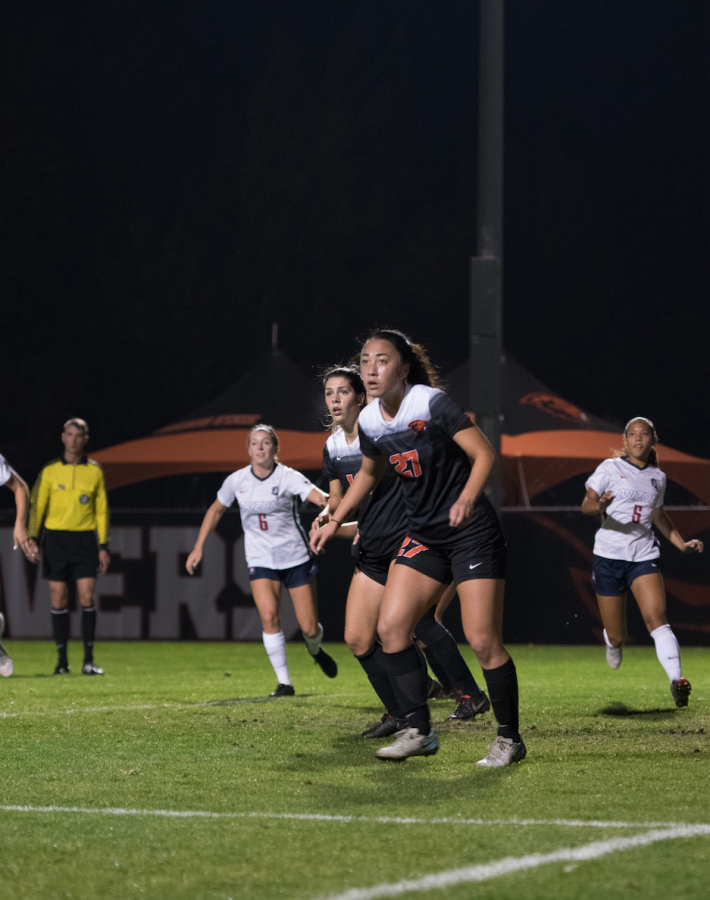Concussion protocol protects OSU athletes
March 4, 2019
Concussions, a problem among college athletes in particular, are defined as a traumatic force-induced process affecting the brain, and if treated improperly can cause sleep dysfunction, migraines, anxiety, depression and even death.
Though an unreported concussion is dangerous, it can be hard for Oregon State University athletes to be honest about their trauma, even with the support they receive from the school. The desire to get back to playing can be overwhelming for some athletes, like Ilihia Keawekane, a freshman on the women’s soccer team.
“It was torture not being able to play,” Keawekane said. “It was mentally depressing, but I knew the head is something I shouldn’t mess with.”
Keawekane struggled to sort out her thoughts between her personal desire to play and her knowledge of the dangers of returning too soon.
“There were times where I was not completely honest so I could get back to playing. I felt pressure from myself,” Keawekane said.
OSU follows a two-pronged approach for the treatment of concussed athletes as part of a concrete Concussion Management Plan.
Firstly, student-athletes are responsible for reporting their own symptoms after suffering from a concussion and being completely honest to the staff Certified Athletic Trainer and/or Team Physician as soon as they shows signs of a concussion and every day following the concussion.
Mckenzie Weinert, a sophomore on the women’s soccer team, got a concussion in October of last year during the middle of the season, and also struggled with being honest about the symptoms she was experiencing.
“The hardest part about having a head injury is being truthful about your symptoms. A lot of times I felt like I was okay and it was just a little headache but as little as it is, it’s still a symptom,” Weinert said.
The second part of the two-pronged approach is, all OSU athletic department members are responsible for reporting any signs or symptoms of a concussion that he or she witnesses to the OSU sports medicine staff.
Weinert got her concussion from someone taking a shot and the ball hit her on the side of the head.
“My trainer ran over to me immediately and pulled me off the field and then asked me questions such as what day is it, who did we play last Sunday, what year is it. Later when we got back to the training room I did a more extensive evaluation including the impact test and eye google test,” Weinert said.
The impact test is an online test that tests multiple things such as speed and accuracy.
If an athlete is concussed they are limited to the amount and types of activity they are allowed to do while showing symptoms of a concussion. During the first 24 hours after getting a concussion the athlete must be accompanied by someone overnight. Both the athlete and the accompanist are given instructions for home care, such as paying attention to specific warning signs.
In order to return to play after a concussion there is a strict protocol athletes must follow. Before beginning the protocol they must be symptom free. After many wellness tests and passing the impact test, athletes are slowly able to return to more aggressive physical activity.
“You bike one day, jog one day, non contact play one day, contact play, and then you can compete fully again. If you have any symptoms during this you can’t go forward to the next step,” Weinert said.
According to the NCAA, there has been an average of 2100 concussions per year in college-level student athletes. At OSU, athletics seem to be a big part of the Beaver culture, community, and entertainment, with a record-setting average attendance in 2018 of 3,594 per men’s basketball game, according to Oregon State University. Concussions are a serious matter, if they are brushed aside it can cause harm to student-athletes.
Concussions affect every person in a different way. No two athletes will experience the same trauma to the head, and the recovery time frame will be unique for each individual.
In order to help prevent concussions in athletes all coaches, volunteer coaches, athletic trainers, physicians, sport administrators, strength coaches, and athletic directors at Oregon State University must undergo concussion education annually.
Dr. Douglas Aukerman the OSU Sports Medicine senior associate athletic director, said all athletic staff and players are informed on the dangers and causes of concussions.
“Education sessions to the coaches and athletes regarding concussion facts and information happen yearly. Coaches teach a safety first approach to sport participation and reduce unnecessary contact during practices,” Aukerman said.
Prior to competing in athletics at OSU all athletes are given educational materials that provide information about head injuries, signs and symptoms of concussions, and the danger of not reporting a concussion. All athletes are required to sign the OSU Student-Athlete Concussion, Injury and Illness Agreement to Self-Report, which states that they have understood the material presented and accept full responsibility for honestly reporting their injuries, and illnesses. This includes signs and symptoms of a concussion.











































































































